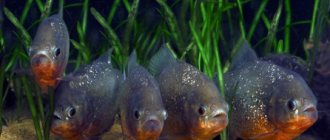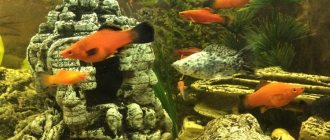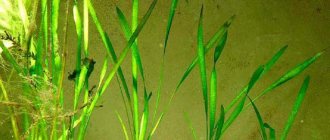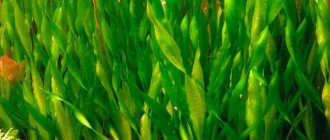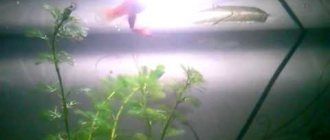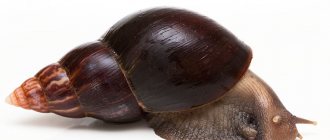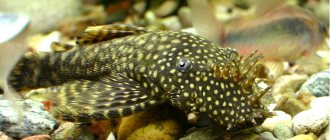Mollies - one of the most popular aquarium inhabitants. Such popularity has led to the fact that mollies have undergone serious breeding work aimed at obtaining various color morphs through hybridization.
White molly or snowflake
White mollies photo
What kind of mollies swims in your aquarium? We can 99.99% believe that this is not a natural form , but a morph. Mollies now in aquariums are almost exclusively hybrids. Both supposedly “latipinae” and supposedly “velifers” are all selection morphs. All mollies with a small dorsal fin are hybrids of Sphenops and Mexican mollies. And all with a large dorsal fin are hybrids of Sphenops, Latipinna and Velifera. So, something like that, friends! Morphs have taken over our aquarium world. Whether it’s good or bad, let everyone decide for themselves.
White mollies is one of the variations of hybridization; it is a colored morph with possibly additional structural changes in the fins and body, originally obtained from the above natural forms of mollies.
From the horror stories of hybridization, let’s say that all fish are “balloons”, including the balloon mollies - this is a selective fixation of a mutation-deformity that arises due to inbreeding (crossing of closely related forms).
Just like all Xanthorist breeds, these are aquarium discoloration mutations. Their breeders fix them genetically. Xanthorists are fish that are discolored by developing a yellow tint instead of red or green. Yellow mollies - xanthorista. White, albinos are super xanthorist freaks. All these are scientific terms without any hype. A freak is an individual with congenital body defects, possibly due to a genetic defect or exposure to negative factors in the embryonic period. And period.
And you say that GLO-fish is wow wow. Here, before Glo, how much wood humanity has chopped up, so mother, don’t worry.
As for the conditions for keeping the snowflake - white mollies , they are standard for all varieties.
Latin name: Poecilia.
Family: Poeciliaceae.
Comfortable water temperature: not lower than 25 degrees, preferably 27. Mollies are heat-loving, and do not tolerate low temperatures well.
Acidity pH: 7-8, which is typical for many viviparous fish - they love a slightly alkaline environment.
Hardness dH: 7,0-8,0.
Aggressiveness: Peaceful, but nimble - fidgety fish.
How long they live: up to 4 years.
Content difficulty: easy.
Molly compatibility: viviparous fish - platies , swordtails ; labyrinthine - gourami , lalius ; non-aggressive and small “dwarf cichlids ”, angelfish , even cockerels (it is worth noting that angelfish and cockerels are soft-water fish, which does not really coincide with the water parameters for mollies).
Molly good video review
Subscribe to our YouTube channel so you don't miss anything
Maintenance and care of mollies
biological balance in the aquarium . All species/morphs of mollies are quite thermophilic and prefer water with a temperature of 25-27 °C and do not tolerate temperature changes well. Like all fish, mollies love fresh water, so a systematic (once a week) change of aquarium water in a volume of ~ 1/3-1/4 is desirable. This manipulation will ensure the absence of high concentrations of nitrogenous compounds in the aquarium - ammonia, nitrite and nitrate . When doing a water change, you need to strictly monitor the temperature. Filtration and aeration of water is necessary.
Every conscientious aquarist should always have a set of drop tests on hand, at least for nitrate and phosphate. Fortunately, they have now become inexpensive, there are no problems with their assortment and acquisition. For example, we can with a clear conscience recommend you the cool UHE drop tests, , but they are sold only online. In stores in your city - offline, you can find inexpensive Vladox tests . Friends, watch out for nitrogen compounds, keep them in check and everything will be fine for you and your pets.
It would be useful to use clean water supply for deep water changes and use preparations that neutralize harmful substances. For example, Tetra AquaSafe - it removes chlorine compounds, heavy metals + contains B vitamins, iodine and other aquarium goodies.
Most of the time, the fish stay in the upper and middle layers of the aquarium. Optimal daylight hours for these fish should last at least 12 hours, so it is necessary to equip the aquarium with open, well-lit areas. Equally important is the presence of stones, snags, thickets of plants, etc. for shelter.
Mollies are an active fish, moderately friendly. It is better to keep her in a group with a predominance of females. Can live both in a general aquarium and in a species aquarium. Gets along well with a variety of neighbors. In general, the “neighbor” fish should be approximately the same size. Mollies get along well with each other - intraspecific aggression is weakly expressed, but at the same time, in a cramped aquarium, males can chase each other. Therefore, it is better to provide a spacious aquarium so that there is at least 10 liters of water per individual.
Nutrition
The basis of the daily diet should be food with a high content of plant components, the absence or deficiency of which affects the health of the fish. In particular, there is a disturbance in the development of the dorsal fin. A good choice for a novice aquarist would be special foods made taking into account the needs of Mollies, produced by many well-known manufacturers in the form of flakes, granules, etc.
Our product Aqvium natural dry food for small and medium fish from clean lakes of Siberia and Northern Crimea in environmentally friendly biodegradable packaging.
Find out more
Feeding Mollies
Mollies are omnivores; their diet should include a sufficient amount of plant food. Feeding any fish should be correct and varied, this is the key to good health. Mollies are very voracious, so it is important not to overfeed them to avoid digestive problems.
You can easily use TetraMin as a base feed. And colorful colored morphs with yellow and red tones can be additionally fed with food containing carotenoids - from the color series.
Allow me to make a small note. Color series food (contains “color” in the name, for example, TetraPRO Color Multi-Crisps) - enhances the natural color of fish (only!!! - red, yellow colors), since it is enriched with pigments such as canthaxanthin, astaxanthin . In fact, carotenoids are natural “coloring” substances. It is astaxanthin that gives plants their red-orange color, carrots are a prime example of this. Or, for example, have you ever wondered why flamingos are pink? Yes, that's exactly why. By eating plant and animal foods rich in carotenoids, the flamingo's plumage, which is initially white, gradually turns pink. The more birds receive this substance from food, the richer and redder the plumage becomes. If you look even deeper, flamingos eat the well-known brine shrimp - pink, saltwater crustaceans and also turn pink.
Actually, the same thing happens to fish if the food contains carotenoids. We also note that astaxanthin also has other beneficial properties - it is also an antioxidant. In general, we can say that carotenoids are beneficial not only for fish, but also for all aquatic organisms, even aquarium plants. The only thing is that everything should be in moderation and balanced. You need to understand that the color of the fish also depends on the state of health, environment, life circumstances (stress/spawning) and the characteristics of the aquarium lighting.
Actually, to summarize, the Color series food is good, but should not be a basic diet. Imagine what will happen to a person who eats only one beet all week =) It’s scary to imagine. The same goes for the fish... sorry, they start pooping cute pink poop.
In this matter, by the way, it is very important not to overfeed the fish, so as not to run into problems with the gastrointestinal tract. Feed molly once a day, do fasting days. This will be one of the keys to success in their maintenance. It should be noted that when purchasing any dry food, you should pay attention to the date of its manufacture and shelf life, try not to buy food in bulk, and also store the food in a closed state - this will help to avoid the development of pathogenic flora in it.
Popular types
Natural species of mollies (there are only 4):
- Poecilia sphenops - sphenops, or small-finned mollies;
- Poecilia salvatoris - free mollies;
- Poecilia velifera - Velifera molly;
- Poecilia latipinna - Latipin molly.
Through the efforts of aquarium breeders, popular hybrids have been developed that can be found in aquariums around the world.
Sphenops
The most popular color of sphenops is black, but other types are also found (white, speckled, yellow). It is almost impossible to find natural gray colors in a decorative aquarium.
The body shape of sphenops is elongated, slightly compressed on the sides, the body of the fish is dense.
Females are larger than males and can reach up to 10 cm in length; males rarely exceed the 6 cm limit.
The fins are small, but the fish are very jumping, and if there is no lid on the aquarium, they can easily jump out and die ingloriously in their prime.
Lyrebird
A distinctive feature of this molly is its unique tail fin. The fish got its name for its resemblance to a lyre.
There is no differentiation by color, since many morphs with this trait have been bred; they can be found not only among sphenopsids, but also among other varieties of mollies.
Two-color
The two-color variety is considered a very valuable specimen among connoisseurs of ornamental aquarium fish.
The front of the body may be golden or orange, while the tail and anal fin are black.
Attention! Fish with a matte black color are highly prized.
Black mollies
This is the most common species of mollies. Color options can vary from matte black to olive brown or black with blue (green) tint to the scales.
Interesting! Black mollys can “regenerate”, that is, change their gender; this property is not lost with age.
Silver spotted molly (Dalmatian)
This molly is not very large, does not exceed 6 cm in length, has a beautiful light color with a silver tint and small black spots, like Dalmatians, which is why it got its name.
It may have some morphological changes in the structure of its fins and their size, but they are usually insignificant.
Mollies balloon
A selection form of the broad-finned variety of molly. Its body resembles an inflated balloon: the ridge is curved and protrudes upward, and the abdomen protrudes strongly downward; it is much shorter than that of other representatives of the genus.
In this regard, dysfunction of internal organs may occur.
Important! These aquarium inhabitants have a tendency to become obese.
Sail molly
The fish got its name for its elegant dorsal fin; in some individuals it can reach the height of the body - such specimens are considered the most valuable breeding representatives.
Males are usually brighter than females and have a more pronounced fin. There are many varieties of color, and there are spotted representatives.
Red leopard
They are distinguished by their red-orange or red color. Sometimes there are individuals with black spots, thanks to which this species of molly received the name “red leopard”. Under favorable living conditions it can reach a size of 12 cm.
Petena mollies
The variety got its name from the place where it was discovered - Lake Petén in Guatemala. It has a pearlescent tint on the scales, a xiphoid process on the caudal fin, and a color without spots.
Sometimes there is a bright red stripe on the fins. These characteristics distinguish molly peten from others.
Marble or chintz
Marbled mollies are highly valued among aquarium hobbyists. It is considered an elite variety and is distinguished by its beautiful marbled color.
High fin green and orange
Large, can reach 12 cm in length. They are distinguished by a high-positioned dorsal fin; The caudal fin is small and round in shape.
Silver mollies
The medium-sized fish with high dorsal fins are distinguished by their noble silver color. Very peaceful. They require increased attention because they are prone to overeating.
Mollies Velifera
Large (up to 15 cm) wide-finned molly with a variety of color options. The fins are set high.
They are distinguished from other varieties by their life expectancy - it can reach 5 years or more.
Snowflakes molly
A very popular variety of mollies with snow-white scales and fins. The tips of the plumage may turn blue.
Large individual specimens reach a size of 14 cm. You should monitor the diet of these beauties: they eat too much.
Freestyle
Rare guests in aquariums: these are representatives of natural fish, and not bred through selective selection. They were found in waters of Guatemala.
They are very unusual due to their multi-colored fins, which can be black, red or white.
Latipinny
Hybrid representatives are more common in aquariums. During selection, this fish has lost its resemblance to its relatives in the wild.
It is noticeably larger than its relatives (males can reach 15 cm, females - 18). They are distinguished by a large rectangular dorsal fin. Coloring can be very diverse.
Dwarf
These are the smallest mollies: males rarely grow more than 3 cm, females - 4 cm. They feel best in an aquarium in schools with a predominance of females.
Yellow
Mollies are medium in size and have a uniform body color of various yellow shades. The most valuable are pale lemon colors. There are dark spots on the plumage.
Golden mollies
A subspecies of sphenops with a lemon-black or golden-yellow color. The scales shine brightly, it seems that the fish shimmers with shades of yellow.
Small-finned molly
They are distinguished by their silvery ventral color and almost transparent fins.
The color can be any. The fish are small in size and have small fins, which determined the name of the species.
Coffee
A variety of velifer with an original color that resembles the color of roasted coffee beans. There may be dark brown markings on the fins.
Orange
Beautiful medium-sized fish with amazing bright orange scales. To maintain the brightness of the color, it is recommended to add food rich in carotene to the fish’s diet.
Albino molly
A variety of albino mollies bred by Thai breeders. It is distinguished by large fins - they can even exceed the size of the plumage of sailfish. They often have a lyre-shaped tail.
Interesting! In adults, yellowish spots may appear on the body.
Reproduction and sexual differences between male and female mollies
Males can be easily distinguished from females; sexual dimophysm is well expressed. In males, the anal fins form gonopodium. Given comfortable conditions, mollies produce offspring monthly. When breeding, the male uses a gonopodium, which has a groove for transferring seminal fluid to the female, and a hook, which allows for better grip during fertilization, increasing the chances of pregnancy. Sexual maturity is reached by fish at about a year of age for males, and for females by six months.
Mollies male and female differences
Pregnancy lasts approximately one and a half months (35 - 45 days). Signs of pregnancy in a female are a dark spot in the lower abdomen and an enlarged abdomen; such a female begins to seek refuge in the secluded corners of the aquarium. It is advisable to place such a female in a small spawning aquarium with water whose parameters are identical to water from a general aquarium.
Spawning usually occurs in the early morning. Large females can give birth to up to hundreds of fry at the same time, their number depends on the age and size of the female. Molly fry are born quite large; they do not rise from the bottom immediately; at first they lie on the bottom and leaves of plants. Molly fry are very sensitive to water contamination, so in the aquarium where they are kept, more frequent water changes than usual are recommended. In order to increase the immunity of the fry, the water can be slightly salted.
For rapid growth, fry need a varied diet; they are fed with “live dust” , ground with high-quality artificial food or special food for fry.
Breeding
White mollies are viviparous aquarium fish, that is, they do not spawn. They have the peculiarity that they are able to change their gender. Snowflakes reach sexual maturity at approximately six months of age. The main indicator of a female’s pregnancy is the huge rounded abdomen, which is obvious enough that it is simply impossible not to notice it. Shortly before spawning, the female of this species swims into vegetation thickets, hiding in shelter from other fish. You need to monitor the behavior of the snowflake, and as soon as this happens, it must be immediately transplanted into a separate small container, not forgetting to place several plant bushes in it. This is necessary so that the born fry can hide among their leaves. Otherwise, the female mollies may eat them herself. For the same purpose, without delay, after spawning, the mother in labor is separated from the fry. One female white molly can bring approximately 60 fry, but it is necessary to carefully maintain the cleanliness of the water in the container, otherwise all the offspring can easily die.
Diseases
Mollies have average immunity. They can easily catch diseases and make the entire aquarium sick.
These fish are sensitive to the level of oxygen in the water. At excessive temperatures, the amount of oxygen is reduced and the fish becomes lethargic. There are also cases with an excess of oxygen (for example, when replacing too much water with fresh tap water). Then the fish may experience a gas embolism (darkening of the gills, restlessness). It goes away on its own over time when the oxygen level in the water returns to normal.
Under unsuitable conditions, the mollies' immunity fails, and tumors begin to grow on the body. At first they look like multi-colored spots, then they degenerate into tumors. The disease is called melanosis and cannot be treated.
In addition, mollies are prone to standard fungal aquarium infections such as ichthyophthyriasis (semolina).
Under good conditions and stable water parameters, mollies do not get sick, live as long as possible and produce healthy offspring.
History of discovery
Achille Valenciennes
Mollies sphenops is the first species in history, which was described by the French zoologist Achille Valenciennes back in 1846. At this time, he was working on writing his 22-volume work, “The Natural History of Fishes.”
50 years have passed, and two species at once fell under the description - velifera and free-ranging mollies. This merit belongs to the ichthyologist-systematist Charles Tate Regan.
1913 - The first wild mollies latipin arrives in Europe.
Charles Tate Regan
Interestingly, the fish were originally assigned to the genus Mollienesia. But modern classification has made clarifications, and now they belong to the genus Poecilia. And their very name Mollienesia is a historical legacy from the original classification.
The year 1920 can be marked as the year of the beginning of active breeding work to develop new forms of mollies. Thanks to the successful crossing of species such as Sphenops, Velifera and Latipine, new hybrids began to appear one after another. A major achievement was the introduction of the black and speckled uniform in 1925. But perhaps the most famous and popular breed was the black-velvet molly, called Black Molly. In the mid-twentieth century, it was so popular that even today, when many lovers mention mollies, they first of all associate with Black Molly. One of the latest breeding trends has been the breeding of mollies, which, due to their similar shape, are called balloons.
Some features
Sometimes completely black parents can give birth to snow-white fry. This is due to both genes (one of the ancestors was white) and the presence of an albino form in mollies. The white color does not necessarily persist into adulthood. During the first month, black dots may appear on the body of the white fry, which increase with age and may even multiply. At 6-7 months, such a molly may already have a black body color, and only in the front part of the back and chest there are white and iridescent spots.
Habitat in nature
It is a freshwater fish from the genus Poecilia, which is part of the family Poeciliidae. These fish are native to the Americas, but their habitats vary greatly. Mainly inhabits coastal areas of North and South America, but are also found where rivers flow into the ocean, in brackish water.
The entire continent can be called their homeland, they are so widespread.
- Black molly or Sphenops (Poecilia sphenops) lives from Mexico to the northern states of the United States.
- The latipin moth (Poecilia latipinna) is found along the southeastern coast of the United States and in Mexico.
- Velifera (Poecilia velifera) or high-finned (sailfin) molly is native to the coastal regions of Yucatan and Mexico.
All of them are distinguished by their wide range, unpretentiousness and omnivorousness, which makes them very common in these areas.
Most species appeared in aquariums back in 1899, and various hybrids since 1920.
Now you can find black molly, snowflake (completely white or yellow), silver, and spotted. And the number of different species continues to grow and gain popularity.
General information
Mollies are considered a popular and unpretentious fish, the maintenance of which can be mastered even by a novice aquarist. This species is characterized by viviparity, which indicates fertilization and development of eggs in the womb of the female. The fry are born fully formed and ready to feed on their own. It is easy to get offspring from mollies even in a community aquarium, which adds to the popularity of this species. The fish are quite large, active and peaceful. They will decorate any aquarium with non-aggressive species.
Fish diseases
The ailments of the individual, like other viviparous representatives of the water element, are associated with an imbalance in maintenance and feeding. The causes of the disease may include the following:
- deviations of temperature and acidity regimes of water from the normal level;
- periodic overfeeding of individuals;
- colds and infections;
- improper change of water environment;
- improper transportation of peace-loving fish.
The following pathological conditions indicate the disease:
- the appearance of local areas on the body covered with small bubbles and mossy formations;
- the formation of dark marks, light spots, tumor formations on the fins;
- general lethargy, irrational trajectory of movement, sinking to the bottom, refusal to eat;
- visual bulging of the eyes.
Diseases of Mollies
Mollies are most often susceptible to the following types of diseases:
- Change of color - melanosis, excess pigmentation turns into a tumor.
- Ichthyophthiriasis, or the so-called fish louse, is a parasitic attack on delicate scales.
- Invasive diseases.
- Ingestion of a foreign body. In this case, the molly begins to move extremely irrationally, often falling to the bottom head down.
- Exophthalmos is fish-like protruding eyes, often leading to loss of vision and death.
- Gas embolism. It is formed as a result of excess oxygen content in the aquatic environment. This phenomenon occurs when the tank is filled with unsettled tap water. The disease is characterized by restlessness and darkening of the gills. Care and therapy here takes place in the form of an urgent change of the aquatic environment.
- Melanosis. The body is covered with blots of non-standard color, which later transform into tumors. This pathology cannot be cured. Preventive measures consist of creating comfortable living conditions; this pathology can be solved in this way. Only tracking key indicators will help you avoid these destructive conditions.
- Cold. If lethargy and apathy appear in the behavior of individuals, they begin to swim near the surface, they experience loss of appetite, then all this indicates a possible cold. The disease attacks when the temperature drops. Care and therapy in this case consists of creating a comfortable temperature regime.
- Hexamitosis in mollies.
Why do mollies die?
Harmful ammonia, nitrates and nitrites begin to rapidly accumulate in the aquarium environment. All these harmful components have a detrimental effect on the protective properties of the fish’s body. It is extremely difficult to cure her of this condition. If timely measures are not taken, this entails the death of the individual.
If intoxication with harmful substances does occur, the following actions will help:
- Regularly change the cloudy liquid to purified water.
- Carrying out a test for the oxygen content in an aquatic environment, using it you can also find out the content of NH4, NO3, NO2. These actions will help bring the indicators back to normal.
- White spots on the body of an individual will disappear when the temperature in the aquarium increases, adding salt and effective antibiotics, increasing the temperature regime.
- If a specimen has bulging eyes, this can cause an infection. In this case, therapy may be required.
Treatment
The nearest pet store has effective remedies for various ailments. The main task of the aquarist is to accurately determine the symptoms. Many ailments arise due to an imbalance in living conditions:
- water filtration;
- necessary aeration;
- insufficient aquarium volumes.
When an illness is detected, the following remedies are often used:
- Effective Tetra Contralck against destructive ciliates, flagellated bacteria (ichthyophthiriasis, semolina, the appearance of white spots).
- Sera bakto Tabs help cope with internal bacterial infections.
Before using a particular medicine, study the description of its properties in detailed instructions.
Prevention
To avoid the development of an unwanted disease, preventive measures are mandatory:
- Regularly change dirty and stale aquarium fluid.
- Cleaning the tank.
- Temperature control.
All these measures will help not only revitalize the aquarium space, but also produce healthy offspring.
Compatibility
First of all, these are completely harmless and peaceful fish. Excellent for general aquariums, compatible with any peaceful and small fish.
They are peaceful most of the time, but may show signs of aggression when the tank is overcrowded or they are surrounded by aggressive neighbors. Therefore, it is important that the aquarium is large enough and that they have suitable neighbors (more on this below).
They should not be kept with predatory and aggressive species. Ideal neighbors would be other viviparous fish: guppies, platies, swordtails. They are also compatible with many dissimilar species: gouramis, angelfish, neons, barbs.
Mollies are active and sociable, so they enjoy swimming together. The pack should be predominantly female, as males are known to harass females.
Reviews
The peace-loving molly is a species worthy of attention. Its ease of care and friendly disposition make it attractive to aquarists. The external conditions of the selection varieties are similar to natural ones. Due to the unpretentiousness of the specimens, the aquarist can choose molly of any tone. The bright color will be the highlight of any tank.
Would you like to get yourself some molly fish? Share in the comments!
How to understand a female's readiness
Females ready for spawning show the following signs:
- abdominal swelling;
- frequent solitude in dense vegetation;
- enlargement of the dark spot near the anal fin.
You can stimulate the throwing of fry by increasing the temperature by 1-2 °C. Do not rush too much - early stimulation may result in underdeveloped fry. In addition, if the conditions in the spawning tank are poor, or the water temperature is above 28 degrees, the fry may appear premature or dead.
Plants
Mollies thrive in aquariums with live vegetation. Therefore, care should be taken to create dense islands with plants, not forgetting to leave free space for swimming. This species loves to eat tender leaves, and fish can also scrape algae from the surface of the ground and decorations.
Velifera molly (snowflake) serves as an indicator of the condition of the aquarium. If there is a lack of oxygen, the fish rise to the top, and if there is an excess of metabolic products, they begin to move more slowly or jerkily and fold their fins.
Description
There are a huge number of different colors of mollies. But there are three main types: sphenops, latipina, velifera. Each of them has special characteristics. Mollies sphenops, or black, is the most common species among aquarium fish lovers. It has a small body, thicker on the sides. The caudal fin, like all the others, is rounded and small. The molly has a small head with pronounced round eyes. The mouth seems to be raised upward. In females, their round abdomen is quite noticeable. Males are identified by their pointed anal fin.


